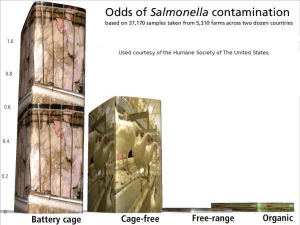For years, the U.S. egg industry has been telling us that there is no connection between salmonella outbreaks and the practice of cramming layer hens into cages so small the birds can’t lift a single wing. It’s been their party line for so long they’ve probably begun to actually believe it. Earlier this year, the leading U.S. egg industry trade group announced, true to form, that caging hens is “better for food safety.”
With more than 95 percent of all U.S. eggs currently coming from caged hens, and salmonella outbreaks sickening more than one million Americans every year, this isn’t merely an academic debate. Salmonella poisons people, causing a nasty, painful disease that can be fatal to the very young, the elderly and anyone with a weakened immune system.
But the evidence that caging hens is bad increases the incidence and the severeity of salmonella outbreaks and other public health dangers is now overwhelming, and even the egg industry is being forced to recognize it. In 2008, the editor-in-chief of the trade journal Egg Industry acknowledged that squishing living birds into tiny cages is bad for public health. Claims to the contrary, he wrote, not mincing his words, are “invalid… unconvincing, unsupportable and easily refuted.”
Though his remarks might not be popular at the next gathering of egg industry moguls, they are in fact correct. There have been nine scientific studies published on the issue in the last five years in peer-reviewed journals. Every single one of them has found increased salmonella rates in eggs coming from facilities that confine hens in cages.
Summing things up, an article earlier this year in World Poultry, aptly titled “Salmonella Thrives in Cage Housing,” found that eggs from hens kept in cages consistently carry an increased risk of salmonella.
On September 6, 2010, the Humane Society of the United States (HSUS) initiated an ad campaign pointing out that every one of the more than half a billion eggs involved in what was then a massive recall due to salmonella came from hens crammed into cages. The ads pointed out that the practice of forcing egg-laying hens to live their entire lives in tiny cages isn’t just an animal welfare concern., Housing hens in cages so small they can’t take a single step is not just inhumane. It is truly a public health menace.
Should we be suspicious of the HSUS? The group is, of course, fundamentally an animal protection organization. But does that automatically mean they are stretching the truth? Not according to a study published in the American Journal of Epidemiology. The study suggests that by switching to cage-free production systems the egg industry would likely reduce the risk of salmonella to the American public from bad eggs by 50 percent. This chart shows why:

Fortunately, we are seeing changes. As of January, 2012, it became illegal to house laying hens in cages anywhere in the European Union. In the U.S., the states of Michigan and California have already passed laws phasing out the practice of confining hens in cages. In California, then-Governor Arnold Schwarzenegger signed a bill requiring that all whole eggs sold in the state be cage-free by 2015. And other states are considering similar legislation.
A number of major fast food eateries, including Burger King, Subway and Wendy’s, and retailers including Trader Joe’s, Safeway and Wal-Mart, have made various levels of commitment to purchasing or selling cage-free eggs. Major food companies like Hellmann’s mayo, which uses 350 million eggs a year, have announced they are going 100 percent cage-free.
McDonald’s in the U.S. has been a little slower to get the message. One of the burger giant’s executives recently said he didn’t think hens “should be treated like queens.” But does going “cage-free” mean the hens will be treated like royalty? Far from it. Cage-free does not mean cruelty-free. But at least cage-free hens have two to three times more space per bird than caged hens. And unlike caged hens, they are able to stand up, fully extend their limbs, lie down and turn around.
From an animal welfare point of view, cage free eggs are far from perfect, but they are better. And from a public health perspective, cage-free eggs are a necessary and urgently needed improvement.
What can you do?
1) Take the HSUS “cage-free pledge.”
2) If you are going to eat eggs, seek out organic and free-range eggs.
3) Never eat raw eggs.
4) Don’t spend extra for brown eggs. They aren’t any more nutritious than white eggs, they are just from a different breed of hens.
5) Don’t be fooled by eggs that claim they are produced without “added hormones. That sounds nice, but is meaningless. No hormones are currently approved for use in U.S. egg production.
6) Beware that the egg industry has been eager to co-opt the language of humane farming. As awareness of the horrors of egg factory farms has been growing in recent years, the industry trade group United Egg Producers responded, not by improving conditions, but by labeling cartons of eggs “Animal Care Certified.” In actuality, this “certification” was only the industry’s misleading attempt to whitewash its tarnished image. After legal action forced them to remove the meaningless label, the industry came up with yet another bogus attempt to hoodwink the public. Egg cartons that say “Produced in Compliance With United Egg Producers Animal Husbandry Guidelines,” are designed to help you feel safe and confident as you purchase eggs that come from filthy disease mills, including the very facilities whose salmonella-infected eggs have been the target of the largest recalls.
7) If you are going to eat eggs, try bypassing the supermarket entirely, and get them from local farmer’s markets. To find one near you, see Localharvest.org.
At the moment, cage-free, free-range and organic eggs are indeed more expensive. Are they worth the added cost? That’s up to you to decide. But the more you learn, the more able you are to make informed choices. When you include the risk of salmonella poisoning, when you take into account the differences in flavor and nutrition, and when you factor in the degree of animal cruelty involved, getting away from eggs that come from concentration-camp chickens starts to seem less like a luxury. The more you know, the more it seems like both an ethical and health imperative.[/vc_column_text][/vc_column][/vc_row]

